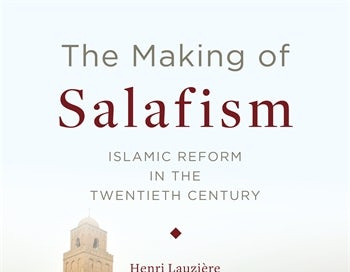Between Purity and Pragmatism: Henri Lauziere’s The Making of Salafism
Short sharp reflection on a modern classic.
The Making of Salafism
The Making of Salafism: Islamic Reform in the Twentieth Century by Henri Lauzière Brooks. 328 Pages. Columbia University Press: 2015.
In The Making of Salafism, Henri Lauziere explores one of the most puzzling questions in contemporary Islamic studies: why does the term “Salafism” encompass both Wahhabi, or purist Salafi, as well as modernist rationalist reformers under a single label? How did these divergent strands come to share the same name? What are their historical roots, and how can we understand the relationship between these movements—and, if they are linked, how did such a relationship emerge?
Lauziere highlights the complex interplay between modernist and purist forms of Salafism and examines the curious feedback loops between orientalist literature and modernist reform movements. In doing so, he provides a vivid tour of transnational scholarly networks and exchanges of the 20th century, focusing on the life of Sh Taqi al-Din al-Hilali (1894–1987) and his extensive travels from the Maghreb to India, to Germany, and to Saudi Arabia. We encounter larger-than-life figures such as King Abdulaziz of Saudi Arabia and public intellectuals like Sh. Rashid Rida, Sh. Bin Baz, and Sh. Albanee. For me, the book is especially illuminating in shedding light on Sh. Rashid Rida’s decision to ally with the Wahhabis and the tensions present in his thought. To my surprise, I found myself sympathetic to the critique of purist Salafism when compared to to that of neo-traditionalist Islam.
Additionally, Lauziere’s analysis shows how each form of Salafism connects to different visions of an imagined global Islamic community, revealing how both territorial-Islamic nationalism and transnational pan-Islamic goals demand different forms of Salafism. This proves significant, as it shows that while Salafis initially took a pragmatic approach by aligning with anti-colonial and nationalist allies, purist rigor increased with the success of independence movements. Once Western influence faded, the character of Islam itself became a central question in forming a pan-Islamic nation. For those with a purist outlook, the unifying ideal was a return to the vibrant purity of Islam’s early predecessors, free from the divisions created by later legal and theological schools. Only this stripped, pristine, and pure Islam, they believed, would be able to unite the lands of Islam. Within these early conceptions of an Islamic state, we may see the origins of some of the tensions between Islamist and Salafi groups that emerged during the Arab Spring, particularly in Egypt and Tunisia.
Over time, Salafism transformed. As the era of decolonization waned, internal conflicts around purity and creed intensified within Salafi circles. One consequence was that points of doctrine that had previously remained undefined or unaddressed became sites of debate, subject to leaders’ interpretations and charisma. While all Salafis upheld the legacy of Ibn Taymiyya and his illustrious student, Ibn Qayyim al-Jawziyya, they disagreed on the meaning of his legacy and the interpretation of his complex body of work. These differences eventually became sources of bitter infighting. Another transformation in Salafism, involved the rise of “manhaj.” This term came to symbolize a holistic view that went beyond doctrine or law; it now encompassed political arrangement and governance, making purity and ideological exclusivity the standard of “true” Salafism. I would seem then, that whereas early Salafis engaged pragmatically with the West or Muslim allies to resist colonialism, today’s purist Salafism focused on purifying Islamic societies from ideological “impurities.” Pragmatism shifted to exclusion, as adherence to a particular group of scholars’ manhaj became the criterion for genuine Salafi identity; it would seem that purity trumps all.
I admit I was surprised how little affected assessment of certain Salafi normative claims after learning about the movement’s origins and historical development. For whilst, Lauziere seems sympathetic to anti-colonial Salafism and less impressed by purist Salafism; ultimately, his study says little about Salafism’s foundational claims other than to reveal that they are historically contingent. Yet this holds true for many schools of thought. Ultimately, a creed’s tenets are judged on their own terms rather than through a historical lens.
Lauziere’s book seems destined to be his opus; all research on Salafism after it has relied on his keystone work. Even if someone updates his research in twenty years, they will owe a debt to his meticulous tracing of Salafism’s evolution into today’s complex landscape. His work may one day be complemented by new findings, but the insights he provides and the clarity of his style will remain integral to our understanding of Salafism’s development.
Reflecting on Lauziere’s study, I am left questioning not just how purist Salafism evolved, but why it emerged as a dominant strand. How did late 19th-century conditions and religious dynamics fuel a purist Salafi movement that critiqued post-classical Islam? An exploration of this context could perhaps reveal whether Salafism’s promise to “reform” Islam remains achievable, and how Salafism can still engage with mainstream Islam, pressing for adaptation rather than nostalgia. It is revealing, for example, that Rashid Rida endorsed Salafi Wahhabi doctrine while viewing mainstream traditions as ossified hindrances to progress. For him, Salafism offered the best hope to unite Muslims and restore their dignity. Perhaps then, the promise of purist Salafism remains unfulfilled, and we need to look at Salafism’s early critiques of Islam instead of getting distracted by its later rigid prescriptions.
Here’s a mega book thread on the book at x/twitter.com I did a while back.




